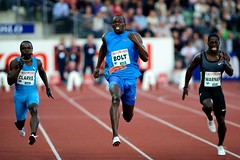Science of the Summer Olympics: the biomechanics of Usain Bolt
By admin
Posted on 2012-08-03
 With the attention of educators across the country focused on STEM, the 2012 Summer Olympics provide a perfect opportunity to create new tools for science teachers. NBC Learn, NSF, and NSTA have partnered to create Science of the Summer Olympics videos with connected lesson plans that will help students apply both the concepts of science and engineering design. The series is available cost-free on www.NBCLearn.com and www.NSF.gov.
With the attention of educators across the country focused on STEM, the 2012 Summer Olympics provide a perfect opportunity to create new tools for science teachers. NBC Learn, NSF, and NSTA have partnered to create Science of the Summer Olympics videos with connected lesson plans that will help students apply both the concepts of science and engineering design. The series is available cost-free on www.NBCLearn.com and www.NSF.gov.
This installment, The Biomechanics of Usain Bolt, focuses on the interaction of knowledge of body systems and application of engineering design processes. In the science classroom, bioengineering is typically connected to work with genes. But the field encompasses a much broader stroke and the video gives students an inside look at how mechanical engineers no longer study only aspects of machinery.
If you’ve used the Science of… series in the past, you’ll notice a change in the lesson plan format. The lesson plans are based loosely on the research of Brian Hand at the University of Iowa, whose science writing heuristic fosters within students a more complete understanding of science concepts. The lesson plans use the videos as springboards to help you involve your students in developing their own questions to explore with liberal use of prompts to keep students focused during their investigations. The depth and complexity of the inquiry falls out of the grade level, background knowledge, and creativity of your students. Although the strategy can be used with elementary students through college-level, the videos and lesson plans are expected to be most successful with middle- and high-school students. A quick search in the NSTA Science Store will give you additional resources on the science writing heuristic.
You may not need another hands-on strategy, but take a look at the lesson plans anyway. Included are ideas for how to incorporate the videos into your own lessons as well as background and timing on the video segments. Then, be sure to let us know how they work for you in real classroom situations. And if you had to make significant changes to a lesson, we’d love to see what you did differently, as well as why you made the changes. Leave a comment, and we’ll get in touch with you with submission information. After all, inquiring minds want to know!
–Judy Elgin Jensen
Photo courtesy of Activ i Oslo.
Video
In “The Biomechanics of Usain Bolt,” Mechanical engineers Dr. Anette Hosoi (Massachusetts Institute of Technology) and Samuel Hamner (Stanford University) study Usain Bolt’s physical structure to help determine how he is able to run so fast. Their findings might enable them to develop solutions for people with movement disorders or to optimize the performance of athletes.
Lesson plans
Two versions of the lesson plans help students build background and develop a question about Usain Bolt, how a movement might be improved, or how bones and muscles work together. Both includes strategies to support students in their own quest for answers and strategies for a more focused approach that helps all students participate in hands-on inquiry.
SOTSO: The Biomechanics of Usain Bolt models how students might investigate factors how bones and muscles work together and how muscle strength impacts an action.
SOTSO: The Biomechanics of Usain Bolt, An Engineering Perspective models how students might apply what they learn in the video or other sources about analyzing actions or how movement might be improved through redesign.
You can use the following form to e-mail us edited versions of the lesson plans:
[contact-form 2 “ChemNow]
Disclaimer: The views expressed in this blog post are those of the author(s) and do not necessarily reflect the official position of the National Science Teaching Association (NSTA).


